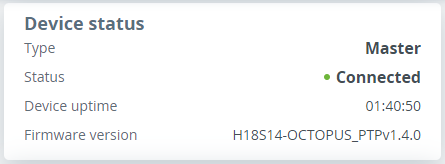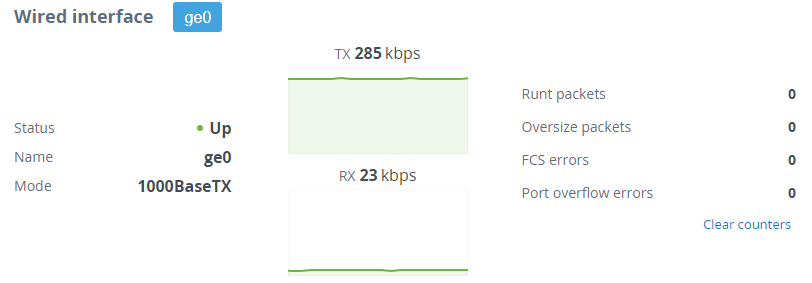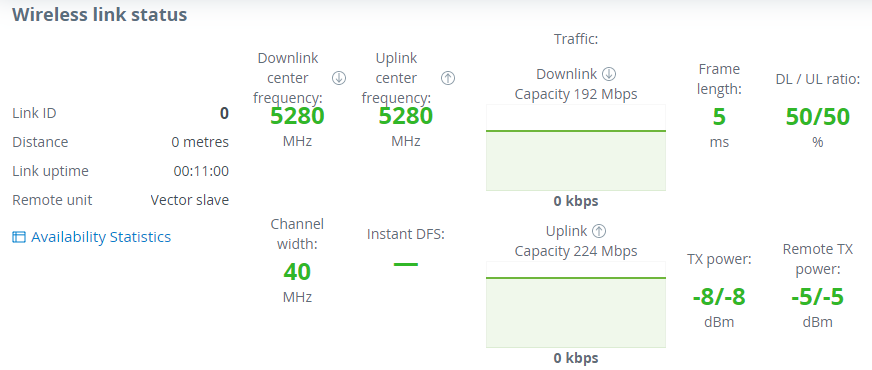Successfully pass the free certification exam at IW Academy and become an Infinet Certified Engineer.
This section is intended to provide the main information about the wireless unit operation.
The Dashboard displays a read-only summary of the current link status information, local and remote device signal strength, capacity for downlink and uplink, current values of the basic configuration settings and Ethernet network status.
Device status
| Параметр | Описание |
|---|---|
| Type | The device type: Master or Slave. |
| Status | Wireless connection state. |
| Device uptime | The device operating time since the last reboot. |
| Firmware version | The firmware version uploaded to the device. |
Wired interface
In the "Wired interface" tab, the Ethernet interface status can be monitored, as well as duplex mode and traffic load for reception and transmission. The wired interface statistic is available on the right side, it can be reset by the "Clear counters" button.
| Parametr | Description |
|---|---|
| Runt packets | Packets less than 64 bytes in size |
| Oversize packets | Packets larger than 1518 bytes |
| FCS errors | Packets dropped due to checksum mismatch |
| Port overflow errors | Packets dropped due to port buffer overflow |
Wireless link status
The “Radio” tab displays the current settings of the wireless connection, as well as the link load in the uplink and downlink directions.
| Параметр | Описание |
|---|---|
| Link ID | Wireless link can be established only with devices which have the same link ID. |
| Distance | The estimated link length. |
| Link uptime | The link operating time since the last outage. |
| Remote unit | The remote device name. |
| Center frequency | The downlink and uplink center frequency value set in the "Radio" section manually or by the automatic frequency selection mechanism. |
| Ширина канала | Значение ширины канала, установленное в разделе "Радио". |
| Instant DFS | Статус опции Instant DFS (только для устройств семейства Vector 5). |
| Трафик | Ёмкость и загрузка беспроводного канала связи в восходящем и нисходящем направлениях. |
| Размер кадра | Значение размера кадра, установленное в разделе "Радио". |
| Соотношение DL / UL | Значение соотношения объёма нисходящего трафика к восходящему, установленное в разделе "Радио" вручную или механизмом автоматического определения оптимального соотношения. |
| Мощность передатчика | Значение мощности передатчика локального устройства, определённое механизмом автоматического контроля мощности для каждой из поляризаций устройства. |
| Мощность удалённого устройства | Значение мощности передатчика удалённого устройства, определённое механизмом автоматического контроля мощности для каждой из поляризаций устройства. |
Modulation code scheme
Modulation and coding schemes are selected independently for each channel (uplink and downlink) for both polarizations. Current modulation for each channel is displayed in the MCS subsection.
Received signal strength indicator
The RSSI indicator displays the received signal level for each channel (uplink and downlink) and both polarizations. Available values:
- -90...-80 dBm - close to the receiver sensitivity level, only the lowest modulations are available.
- -80...-60 dBm - average input range.
- -60...-40 dBm - the recommended range for achieving best performance.
- >-40 dBm - input signal level is too high.
EVM
Error vector magnitude - indicator of the measured input signal quality, telling how far are the received constellation symbols compared to the ideal symbols of the constellation. The parameter value must be as high as possible in absolute value.
The recommended level should be less than -21 dB.
Retries and Frame loss
Retried and lost packets need also to be tracked. Retries should tend to zero, link with the retries value more than 5% should not be allowed to operation.
NOTE
Downlink - the direction from Master to Slave, Uplink - the direction from Slave to Master. These directions are correct for the whole link and do not depend on the roles of the devices.






